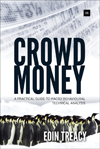Book review: make technical analysis work for you
If you’re a trader, then Crowd Money is a book that you should definitely read, says Matthew Partridge.


by Eoin Treacy
Technical analysis the idea that the past price movements of a share or commodity can be used to predict the future is controversial. Many investors, especially short-term traders, swear by it, and have built careers from using it. Others believe it is nonsense and prefer to look at fundamental factors, such as economic growth. Recently, there has also been an explosion of interest in the impact of emotions and crowds on markets.
Crowd Money: A Practical Guide to Macro Behavioural Technical Analysis, by MoneyWeek contributor Eoin Treacy (who writes this week's cover story on robotics), explains how you can combine all three approaches: technical, psychological and fundamental, to spot opportunities in today's markets.
MoneyWeek
Subscribe to MoneyWeek today and get your first six magazine issues absolutely FREE

Sign up to Money Morning
Don't miss the latest investment and personal finances news, market analysis, plus money-saving tips with our free twice-daily newsletter
Don't miss the latest investment and personal finances news, market analysis, plus money-saving tips with our free twice-daily newsletter
Treacy discusses several technical indicators, but essentially they fall into two main types. The first is the divergence between the current price and the moving average. Most traders like to buy shares that are moving above their moving average. However, Treacy takes the opposite approach, waiting until the gap between the two becomes large, and then betting in the opposite direction, on the assumption that they will re-converge. To support this approach, he points to the evidence that crowds can frequently assume a mob mentality, and succumb to extreme emotions, causing bubbles and panics.
The second type covers price ranges and breakouts, and Treacy's approach here is a little more complicated. On one hand, he looks for emerging price trends, and attempts to buy into them when they appear. However, he emphasises thattrends eventually come to an end, so he also explains whystop-losses are a key component of any traders' armoury, andexplains how exactly to deploy them. Indeed, he pays a lot ofattention to spotting trends that have gone too far, so that hecan then bet on a reversal.
The final chapters, covering around a third of the book, focuson more fundamental factors affecting markets. Unsurprisingly,one of these is monetary policy, which played a big role inthe recovery from the financial crisis, and now threatens todo the opposite as rates gradually return to normal. The riseof emerging economies and the emergence of the globalmiddle class is another trend that looks set to continue. The last chapter of the book looks at 150 stocks that Treacy calls"autonomies" meaning global companies that are set toflourish in the near future.
Combining all three of these topics into a single book isambitious and arguably Treacy might have done better to focuson technical analysis and psychology, and leave discussionof these fundamental trends to a separate book.
However, theexplanations of chart-reading and technical analysis go a longway to making topics that can seem confusing and esotericto the layman relatively simple and accessible. Similarly,the material on psychology and behavioural finance is clear,convincing and persuasive. Even those who are still scepticalabout the value of these approaches will have to admit thatthere is a lot of evidence to back them up. If you're a trader,then this book is something that you should definitely read.
Crowd Money: A Practical Guide to Macro BehaviouralTechnical Analysis by Eoin Treacy, is published byHarriman House (£45).
Get the latest financial news, insights and expert analysis from our award-winning MoneyWeek team, to help you understand what really matters when it comes to your finances.

-
 ‘Why I have ditched my Help to Buy ISA for cash savings and the stock market’
‘Why I have ditched my Help to Buy ISA for cash savings and the stock market’Without the 25% bonus, my Help to Buy ISA is effectively redundant, says MoneyWeek writer Sam Walker.
-
 Is your inheritance tax allowance cut if you sell to downsize or sell your home to pay for care?
Is your inheritance tax allowance cut if you sell to downsize or sell your home to pay for care?Downsizing relief is a little-known benefit that could save your loved ones tens of thousands of pounds in inheritance tax after you’ve died.